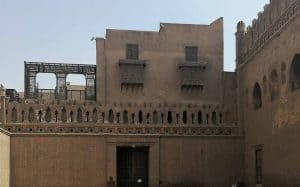Sacred Wells and Their Significance in Celtic Culture: Exploring Ancient Spiritual Traditions

Updated On: April 20, 2024 by Yasmin Elwan
Sacred wells hold a venerable place in Celtic culture, embodying a bridge between the earthly and the divine. In Ireland and across the Celtic lands, these natural springs and pools have long been revered as sites of spiritual significance. The Celts, known for their deep connection to the land and its elements, considered wells to be a direct line to the otherworld, often attributing them with healing properties and the presence of the divine or supernatural.

Their cultural importance spans centuries, with instances of worship and ritual dating back to pre-Christian times. Even as Christianity spread across the Celtic regions, many sacred wells were integrated into the new faith, merging ancient traditions with Christian practices. These wells pepper the landscape of Celtic territories, serving not only as places of reverence and ritual but also as focal points of local communities, linking the past to the present through an unbroken thread of tradition and belief.
Historical Context of Sacred Wells
In our exploration of history, we find that sacred wells possess a profound significance within Celtic culture, offering us insights into both spiritual practices and societal norms of ancient times.
Role of Wells in Celtic Traditions
Wells and springs held deep spiritual significance for the ancient Celts. They were not only sources of water but were also revered as gateways to the Otherworld, imbued with healing properties, and considered dwelling places of deities. Festivals and rituals often took place at these sacred wells, highlighting the intertwining of natural elements with spiritual beliefs in Celtic society.
Transition from Pagan to Christian Practices
The arrival of the Roman Empire and later the spread of Christianity saw a transformative period where pagan well worship was gradually assimilated into Christian rituals. Many pre-Christian sites were Christianised, maintaining the sanctity of wells. Christians often dedicated these wells to saints, yet, they continued to serve as sites for local gatherings and ceremonies, reflecting a syncretism of traditions across the centuries.
Geographical Distribution and Types

In the British Isles, sacred wells, often known as holy wells, are significant historical and cultural landmarks. These sites are predominantly found in Ireland, Wales, and Scotland, where they are traditionally associated with healing and ritualistic practices.
Ireland’s Holy Wells
In Ireland, holy wells are abundant and renowned for their spiritual significance. Each well often boasts a unique connection to a patron saint and is a place of pilgrimage, especially on the saint’s feast day. For instance, St. Brigid’s Wells in County Kildare is thought to possess healing properties and receive numerous visitors. These wells are typically natural springs or lakes, and it’s not uncommon to find them adorned with offerings or markers of devotion, such as coins or ribbons.
Wells in Wales and Scotland
Wales and Scotland also host a variety of holy wells, some of which are interwoven with local folklore and myths. In Scotland, the Clootie Well, a natural spring near Inverness, is a quintessential example of how traditions evolve; visitors tie cloths to the nearby trees as part of a healing ritual. In Wales, holy wells can be both natural formations or more structured, with some embodying intricate architectural features. These wells across Wales and Scotland echo the cultural reverence for natural water sources seen in Ireland, affirming the sacred nature of such sites throughout the Celtic tradition.
The Sacred and the Supernatural
In delving into Celtic culture, we quickly encounter a rich tapestry of beliefs that intertwined the sacred with the supernatural. Holy wells serve as a focal point for this fusion, with their waters believed to be touchpoints to the otherworld and home to deities and nymphs.
Myths and Legends
Celtic mythology is replete with tales that speak of holy wells as gateways to the otherworld. Such locations are often depicted as the dwelling places of spirits and other supernatural entities. The legends associated with holy wells typically involve themes of healing, blessings, and sometimes curses, reflecting the well’s dual nature as a source of both benevolence and malevolence.
Deities Associated with Wells
Within these myths lie deities closely associated with well waters, believed to possess powers that could be petitioned by those who knew the proper rituals. Nymphs, like the famed naiads of Greek mythology, are also said to inhabit these sacred springs, guarding their secrets and granting favours to the faithful. Each well often had its patron deity, reflecting the local terrain and the Celtic tribe’s history in that region.
Cultural Practices and Rituals
In the ancient Celtic world, sacred wells played a pivotal role in religious and cultural practices. These sites were not merely natural features but were imbued with profound spiritual importance.
Pilgrimage and Veneration
We recognise that for the Celts, undertaking a pilgrimage was a spiritual quest, often culminating at a sacred well. These wells served as conduits for the divine, places where the veil between the worlds was considered thin. Here, pilgrims would come with deep reverence, seeking healing, wisdom, or the blessing of the deities. The sacred journey often involved prayers and contemplation, tied intrinsically to the mystical landscape around the wells.
Offerings and Clootie Wells
At these sites, offerings and votive offerings were made with the intent of gaining favour or expressing gratitude to the divine. Precious items, sometimes personal belongings, were deposited as a sign of faith and hope for answered petitions. A unique practice was observed at clootie wells, where pieces of cloth or rags, referred to as clooties, were tied to nearby trees. As the clootie decayed, it symbolised the fading of ailments or the transfer of afflictions to the spiritual realm. These clootie wells were an eclectic blend of pagan rituals and later Christian influences, reflecting an enduring cultural tapestry.
Healing and Medicine

In the rich tapestry of Celtic culture, sacred wells hold a significant place, particularly in the realms of healing and medicine. These wells were not only sources of physical water but also a focal point for spiritual wellness and community healing practices.
Healing Waters and Their Users
Historically, we find that Celtic wells were often deemed to have therapeutic properties. Individuals seeking relief from various ailments would frequent these sites, hoping to find cures for their illnesses. In Ireland, for instance, the tradition of visiting holy wells for their healing waters is well-documented, with visitors hoping to alleviate symptoms of physical or emotional stress. These wells were, and in some cases still are, regarded as places where one could seek healing not only for the body but also for the soul, as described in discussions about Ireland’s sacred spaces and the ancient art of healing.
The users of these healing waters came from all walks of life – from locals who lived in nearby communities to pilgrims who travelled great distances. Believers in their efficacy would often leave offerings or perform rituals, hoping that the sanctified nature of the wells would grant them health and wellbeing.
Modern Interpretations of Healing
In contemporary times, our understanding of healing properties associated with sacred wells encompasses more than direct remedies to illnesses. Rather than seeking miracles, many people now interpret these sites as providing a form of psychological or emotional relief. Visiting a well for its tranquil environment, for instance, can offer a respite from the hectic pace of modern life and promote stress reduction.
Moreover, the narrative of healing waters has also merged with modern holistic wellness practices. Although the explicit magical connotations may have diminished, the understated calm and serenity of holy wells do offer an avenue for reflection and rejuvenation, aligning with current interpretations of mind-body wellness. This modern perspective on the ancient tradition of healing wells is supported by anecdotal accounts and the growing popularity of natural and spiritual wellness therapies.
The Wells in Folklore and Modern Culture
Wishing wells hold a special place in folklore and continue to fascinate in modern culture, inviting a closer look at tales and superstitions surrounding them, as well as inspiration they provide.
Tales and Superstitions
Within Celtic culture, sacred wells are often the stage for folklore and legends. Tales tell of waters endowed with the supernatural ability to cure ailments or foretell the future. For instance, visitors often cast coins into these mystical waters as offerings to deities or spirits that were believed to reside there, a superstition that secured their wishes. This practice has endured, linking past beliefs with contemporary customs, exemplified in towns where people still engage with these historic traditions.
Wells as Inspiration
Sacred wells have also acted as deep inspiration across various forms of art and storytelling. They have featured prominently in stories shaping literature and film, echoing the enduring allure of these mystical sites. Moreover, in modern times, sacred wells prompt artists to create works that interweave ancient symbolism with contemporary narratives, inspiring both creators and audiences alike. This confluence of past and present renders cultural significance that stretches beyond physical sites and into the realm of collective imagination.
Physical Attributes and Natural Science

Before we delve into the mystical allure of Celtic sacred wells, it is essential to consider the physical attributes and natural sciences that define these vital water sources. Here, we demystify the origins and ecological significance of springs and wells, elemental to the sustenance of ecosystems.
Understanding Water Sources
Springs and wells are natural occurrences where water flows to the surface from an underground aquifer. These water sources can be the result of natural pressure or the intersection of the water table with the Earth’s surface. Geologically speaking, springs may emerge due to a variety of underground formations, including fissures, porous stones, or between layers of impermeable rock and soil.
Ecological Importance of Springs and Wells
Ecologically, these bodies of water are of paramount importance as they not only support a myriad of aquatic species, but also serve as critical sources of fresh water for surrounding flora and fauna. As stable year-round sources of clean water, springs often give rise to vibrant ecosystems. These ecosystems are dense in biodiversity and contribute significantly to the purification of water by filtering sediments and facilitating nutrient cycling in their surrounding environments.
Sacred Wells and Christianity
Before the spread of Christianity, sacred wells were widespread in Celtic lands, revered for their healing properties and connection to the divine. As Christianity took hold, many of these wells were transformed, finding new purpose within the Christian faith.
Transformation into Christian Holy Sites
We observe that the arrival of Christianity did not eradicate the reverence for sacred wells; instead, it redefined their significance. These sites often became baptismal founts, integrating Celtic tradition with Christian practices. Christian churches were frequently constructed near these holy wells, intertwining the natural sanctity of the well with the ecclesiastical.
- Baptism became a central ritual at these wells, symbolising purification and rebirth.
- Many wells that were once pagan shrines were consecrated with the sign of the cross, becoming officially recognised by the Christian community.
Saints and Holy Wells
Celtic wells were often rededicated to saints, serving as centres for pilgrimage and ritual. People would come from afar, drawn by the legends of healing and miracles attributed to these wells.
- Saints such as St. Brigid had wells named in their honour, infusing local beliefs with Christian narratives.
- The customs surrounding the wells included prayers and offerings, with the faithful observing long-standing rituals in a Christian context.
The reverence attributed to holy wells with Christian influence is a testament to our capacity to blend tradition with newfound beliefs. Sacred wells remain a part of our spiritual and cultural landscape, embodying a fusion between ancient customs and Christian faith.
Archaeological and Historical Insights

In this section, we explore what excavations have revealed about sacred wells and their role within Celtic and subsequent cultures, as well as how we interpret these archaeological findings today.
Excavations and Findings
Recent excavations at sacred well sites have unearthed a variety of artefacts that shed light on their significance. At some locations, archaeologists have discovered votive offerings that suggest a ritualistic use of these sacred spaces. For instance, metalwork, jewellery, and coins have been found, indicating that people may have offered valuable items to deities or spirits associated with the well. The presence of sacred trees at these sites, as unearthed by one survey of holy wells, further underscores their religious importance. Types of trees such as ash, oak, and yew were often associated with these wells and believed to possess spiritual properties.
In Ireland, archaeological research into holy well sites has also highlighted the intersection of Celtic traditions and the Roman Church. The superimposition of Christian shrines on these sites points to a complex layering of religious practices, wherein Christian elements merged with or supplanted earlier beliefs.
Interpreting Archaeological Evidence
The interpretation of archaeological evidence from sacred wells is delicate. Artefacts and structural remains must be contextualised within broader historical and cultural narratives. It’s not merely about cataloguing objects but understanding the connotations they carried in ancient times. For example, the practice of votive deposition speaks to the exchange relationship people felt with divine forces, a theme that crosses cultural boundaries. As archaeologists continue to examine these sites, their findings prompt us to consider the evolution of religious practices and their intertwining with everyday life in historical societies.
In addition, the investigation of Roman diffusion versus indigenous origins of holy wells remains an area of academic debate. The Roman diffusion hypothesis, suggesting the spread of these traditions via Roman influence, contrasts with theories advocating for a purely Celtic origin. The archaeological record thus not only informs us about the past but also ignites discussions about cultural interactions and the development of religious landscapes in post-Celtic and Christian times.
Protection and Preservation

Sacred wells have long been intrinsic to the cultural heritage of Celtic societies, often deemed as reservoirs of ancient traditions. It is therefore paramount to ensure their ongoing conservation and protection to maintain this connection with the past.
Conservation Efforts
Efforts to safeguard these sacred sites involve meticulous approaches to restoration and management. We engage in routine maintenance to prevent the overgrowth of vegetation and the accumulation of litter, as both can obscure and degrade these treasured sites. The collaboration between local heritage groups and international conservation organisations ensures that the protection of holy wells is both a community initiative and a global concern. Our approach emphasises sustainable practices that honour the ecological balance of these environments.
Cultural Heritage Sites
Classifying holy wells as cultural heritage sites enables us to afford them greater legal protection and raise public awareness about their significance. Many sacred wells are recognised on account of their historical value and the role they’ve played in local traditions. By working with bodies that oversee heritage management, such as UNESCO, our aim is to secure lifelong preservation. We encourage respectful visitation and educate visitors on the crucial role these sites play in our cultural identity. The fabric of our history is bound closely with these wells, and as such, their preservation is a testament to our commitment to our ancestors and the insights they provide into ancient Celtic spiritual practices.
Frequently Asked Questions

In this section, we address common inquiries surrounding the mystical holy wells of Celtic lands and their enduring legacy.
What is the cultural significance of holy wells in Ireland?
Holy wells in Ireland are ancient sites of spiritual significance, often linked to Celtic and Christian traditions. They are considered gateways to the sacred, serving as focal points for healing, ritual, and reverence.
How were holy wells used in Celtic religious practices?
During Celtic times, holy wells were integral to religious practices, with many believing that these sacred waters harboured divine properties. They were places of pilgrimage, where offerings were made and rituals performed to earn favour with the deities.
What are some of the traditions associated with visiting holy wells in the UK?
Visiting holy wells in the UK often involves age-old traditions such as circling the well in a sunwise direction, leaving offerings, and taking water for its perceived healing qualities. These customs uphold a connection to the region’s ancestral beliefs.
Can you explain the symbolic representation of water in Celtic beliefs?
Water in Celtic beliefs symbolises life, purification, and the boundary between the earthly realm and the otherworld. Its fluidity and depth are seen as carriers of wisdom and a means to communicate with the divine.
What historical importance do sacred wells hold in terms of heritage conservation?
Sacred wells hold significant historical importance as they embody the intersection of spirituality, nature, and community across centuries. Their preservation is essential to understanding the cultural and religious landscape of our ancestors.
How has the perception of holy wells changed over the centuries within Celtic regions?
Over centuries, the perception of holy wells has evolved from central elements of Celtic spirituality to more historical curiosities. They have transitioned into cultural markers that continue to inspire respect for our heritage and the natural world.






